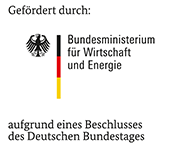16110 BG

Hochtemperaturofen in Betrieb
| Period: | 2009-06-01 to 2011-11-30 |
|---|---|
| Funder: | Federal Ministry for Economics and Technology (BMWI, Germany) via AiF |
| Project Manager: | Dr. Alexander Donchev |
| Research Group: | High Temperature Materials |
Titanium alloys are widely used as structural materials. The density of Ti is about 4.5 mg/cm3 and thus much lower than that of steels or Ni-based alloys. The use of Ti-components at elevated temperatures would contribute to increasing the efficiency of turbines and to saving fuel. The rutile layer (TiO2) formed in oxidising environments protects the metallic component at room temperature or lower temperatures (passivation). At higher temperatures (>600°C) the oxygen inward diffusion becomes the rate-determining step because the crystal structure of TiO2 has a lot of defects. Therefore, oxygen is enriched in the subsurface zone which causes embrittlement. Up to 25 wt.% O2 can be dissolved in α-Ti. Another disadvantage of pure Ti is the susceptibility against titanium fire.
To overcome these problems the surface of Ti compounds has to be modified. Al enrichment of the surface by coatings was done already but this attempt was only slightly beneficial. The combined Al enrichment plus additional fluorine treatment proved to be much more beneficial. The fluorine effect known from TiAl alloys could be transferred to Ti alloys. The formation of an Al2O3 scale was promoted by the fluorine and this layer was protective against environmental attack even under thermocyclic conditions and prevented the oxygen diffusion into the substrate. The parameters for the Al enrichment were determined and additionally flourine implanted at the Helmholtz-Zentrum Dresden-Rossendorf (HZDR) by plasma-immersion-ion-implantation (PI3). The PI3 technique allows the implantation of complex geometries and is cheaper than the conventional beamline implantation. The Al enrichment was performed at the DFI. The investigations of the corrosion behaviour and the mechanical properties of the untreated and treated alloys were observed also at the DFI. This project was a cooperation between the DFI and the institute of ion beam physics and materials research of the HZDR.

Das IGF-Vorhaben Nr. 16110 BG der Forschungsvereinigung DECHEMA e.V., Theodor-Heuss-Allee 25, 60486 Frankfurt am Main wurde über die AiF im Rahmen des Programms zur Förderung der industriellen Gemeinschaftsforschung (IGF) vom Bundesministerium für Wirtschaft und Energie aufgrund eines Beschlusses des Deutschen Bundestages gefördert.
Dr. Alexander Donchev
Tel.: +49 69 / 7564-386
E-mail: alexander.donchev
Final Report (pdf, 3.3 MB, in German)